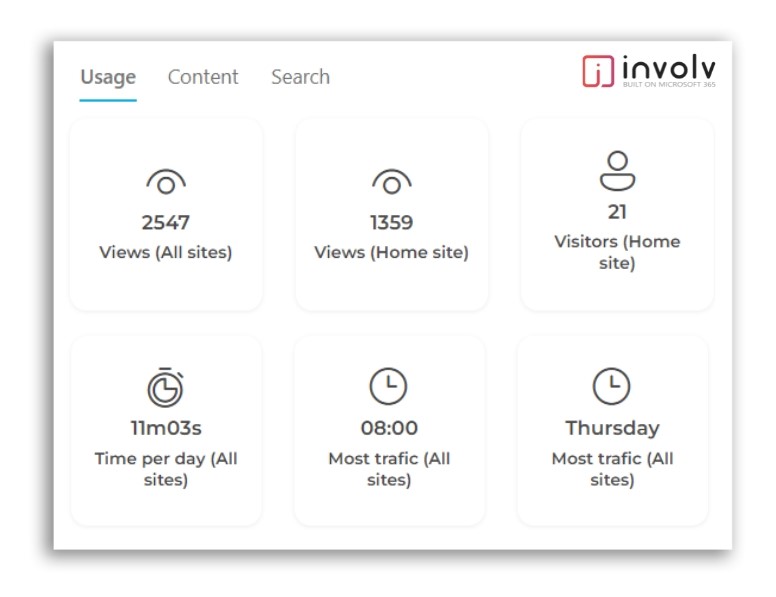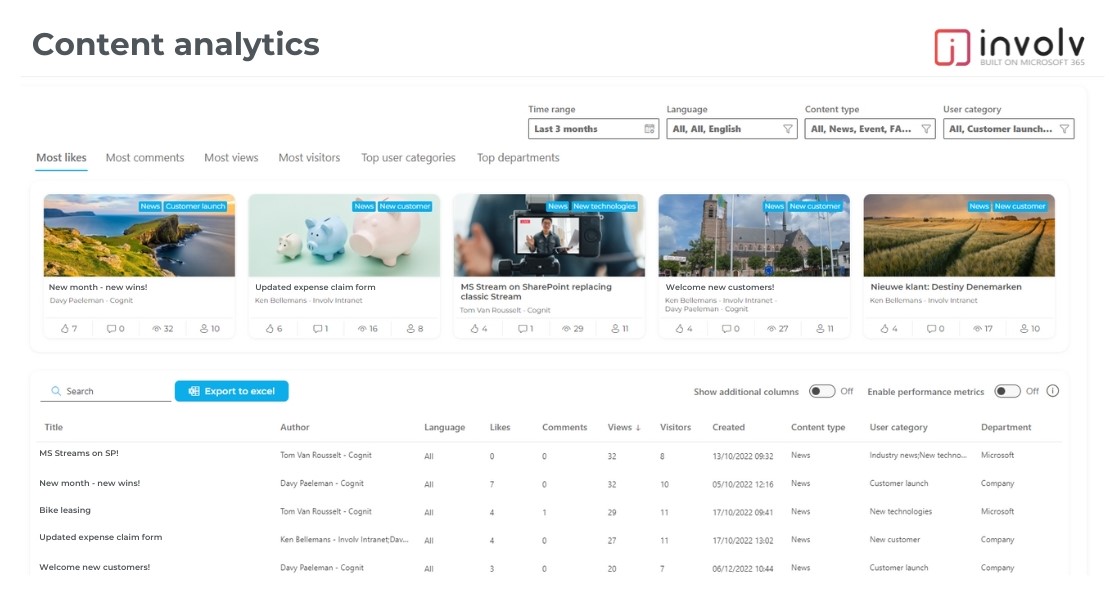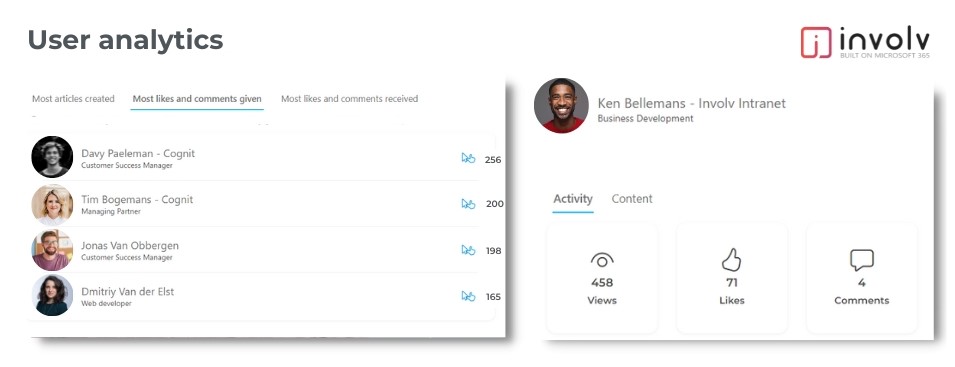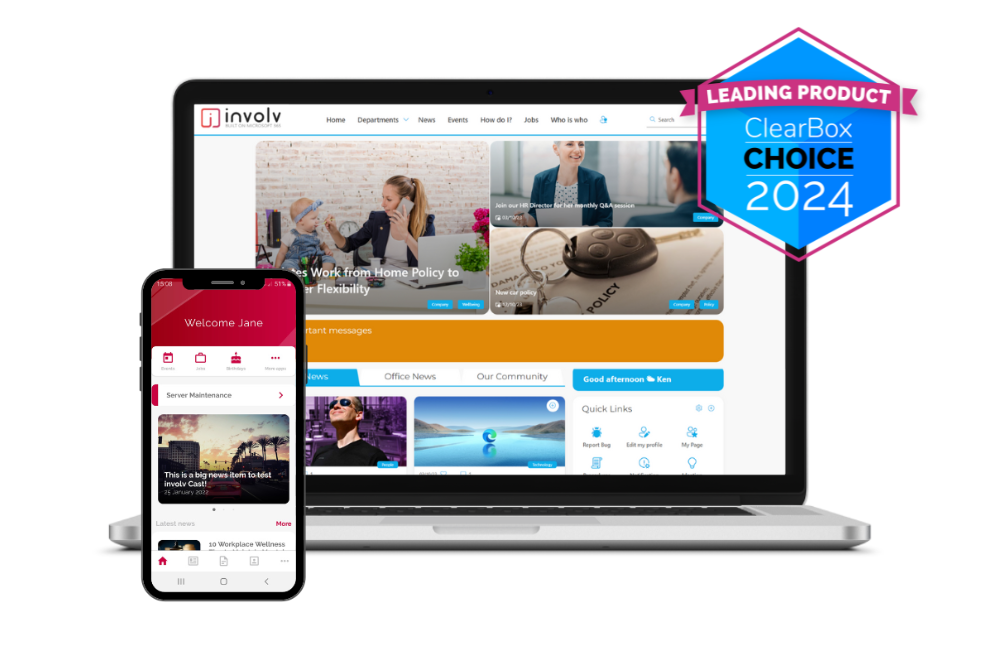You’ve invested a ton of effort into building the company intranet, but how can you tell if it’s truly effective?
In this blog post, we share 6 powerful KPIs that will help you objectively quantify your intranet’s impact and unlock its full potential as a strategic business asset.
By consistently tracking and analyzing the most relevant KPIs, you’ll gain invaluable visibility into strengths, weaknesses, user adoption levels, and opportunities for optimization.
The 6 key Intranet metrics to track
1. Usage metrics
At the most basic level, most intranet managers monitor usage metrics to gauge the overall adoption and usage levels.
Key metrics in this category include:
- Number of views
- Number of visitors (reach)
- Average time spent on the intranet
- Peak days and times for traffic
- Number of mobile views and logins
- Percentage of team members are using the intranet
With Involv’s intranet analytics center, you can find these usage metrics directly on the dashboard. You can even drill down to see content-level metrics to analyze the performance of specific pieces.

2. Content engagement metrics
While usage shows if people are visiting your intranet, content engagement digs deeper into whether they’re truly interacting with what you publish. You could have high traffic but low engagement – a clear sign your content needs improvement.
So, when publishing new content, measure things like views, visitors, likes, and comments. Tracking engagement helps you learn which content resonates biggest and informs your future content planning.
Involv’s content analytics provide a bird’s-eye view of all the different types of content across your intranet, including multi-language articles and engagement data. At a glance, you can quickly identify top-performing content based on key engagement metrics. The tabbed interface makes it easy to toggle between sorting top pages by views, visitors, likes, comments. And the search box helps you instantly find the metrics for any published piece.

3. User metrics
Employees who use your intranet more than others can include designated “super users” who act as intranet ambassadors.
Keeping track of these highly active intranet users is extremely valuable. They provide great feedback on what works well, what doesn’t, and what improvements they’d like to see. Getting their opinions helps make the intranet better for everyone.
Identifying your top users is easy with the right tools. They are typically the ones creating, liking and commenting on content frequently. With user analytics like the one in Involv, you can easily see:
- Users who created the most articles
- Users who gave the most likes and comments.
- Users who received the most likes and comments.
This makes it simple to identify your highest-engagement employees across different teams and locations. These are your “intranet experts” to collaborate with.

4. Satisfaction metrics
This subjective metric is crucial for understanding whether your intranet actually resonates with its end-users and meets their needs. By regularly gauging satisfaction levels, you can pinpoint areas for improvement.
Send out short surveys often. Use ratings to gauge overall happiness, but also satisfaction with specific features, tools, and recent changes.
Some insightful questions to ask:
- Would you recommend our intranet to coworkers?
- What features do you like most/least?
- How good is the mobile experience?
- Are recent updates actually helpful or not?
- How easy is it to find what you need on the intranet?
To get honest feedback, allow anonymous responses. People are way more likely to share the good and bad stuff when their name isn’t attached.
Within Involv, we have a built-in poll app perfect for conducting regular intranet satisfaction surveys. Involv also integrates seamlessly with Microsoft Forms – another great tool for gathering team feedback.

5. Search metrics
An effective intranet acts as a centralized knowledge hub, with robust search capabilities to quickly surface information and expertise. Search metrics provide crucial insights into whether your intranet is delivering on that promise. If employees can’t find what they need through search, it severely hinders productivity and undercuts the intranet’s core value proposition.
So it’s important to track these metrics:
- Total searches
- Most searched terms
- Successful vs failed queries
- Recent searches
- Recent successful and unsuccessful searches
If certain queries consistently yield no/irrelevant results, you likely have a content gap that requires filling. Seamless findability translates to saved time and boosted productivity, so prioritize these metrics.
6. Efficiency metrics
For many organizations, a key reason for implementing an intranet is boosting operational efficiencies – reducing manual work, streamlining processes, cutting down on emails and calls to service teams.
Efficiency metrics directly measure whether your intranet investment is paying off by saving costs, saving time, and increasing productivity from self-service and automation features.
Track metrics like:
- Number of IT support requests
- Number of IT support requests
- Percentage decrease in total email volumes
- Percentage decrease in emails, calls or tickets to in IT, HR, administration etc.
You can also look at the related metrics to prove the value of the intranet, including:
- Cost savings from reduced printing and paper waste
- Cost savings from internal job postings on the intranet
- Employee surveys on intranet usefulness/time savings
By incorporating these metrics, you can comprehensively evaluate the success of your intranet across various dimensions, including user adoption and satisfaction, community engagement, cost savings, and time efficiency.
Equip Your Team with Robust Intranet Analytics for Data-Driven Success
The latest State of IC Sector report found that lack of quality analytics is still one of the biggest hurdles comms teams face, especially at larger organizations. Deficient analytics leave teams flying blind, unable to make informed, data-driven decisions.
That’s why choosing an intranet with powerful but simple analytics built-in is so important. You need a platform that makes it easy for your team to see the metrics that really matter.
Involv’s analytics center does just that, earning praise from reviewers for how well it’s designed. As the 2024 Clearbox review stated:
“We particularly like how the analytics are laid out so that the major functions of the platform have their own sections, then within these the information is presented clearly and logically. We also like how each page shows KPIs for each section, with the ability to drill into more detail.”
– 2024 Clearbox Intranet and EXP report –

As an intranet administrator, Involv’s centralized analytics allow you to:
- See the intranet adoption rates across departments and locations.
- Analyze content performance metrics to measure impact and resonance.
- Check if the search is working well or needs improvement.
- Monitor user behavior and engagement.
- Identify the intranet influencers and power users.
Don’t settle for an intranet that leaves you guessing. Get the in-depth insights you need to truly maximize your intranet’s impact with Involv Intranet.


